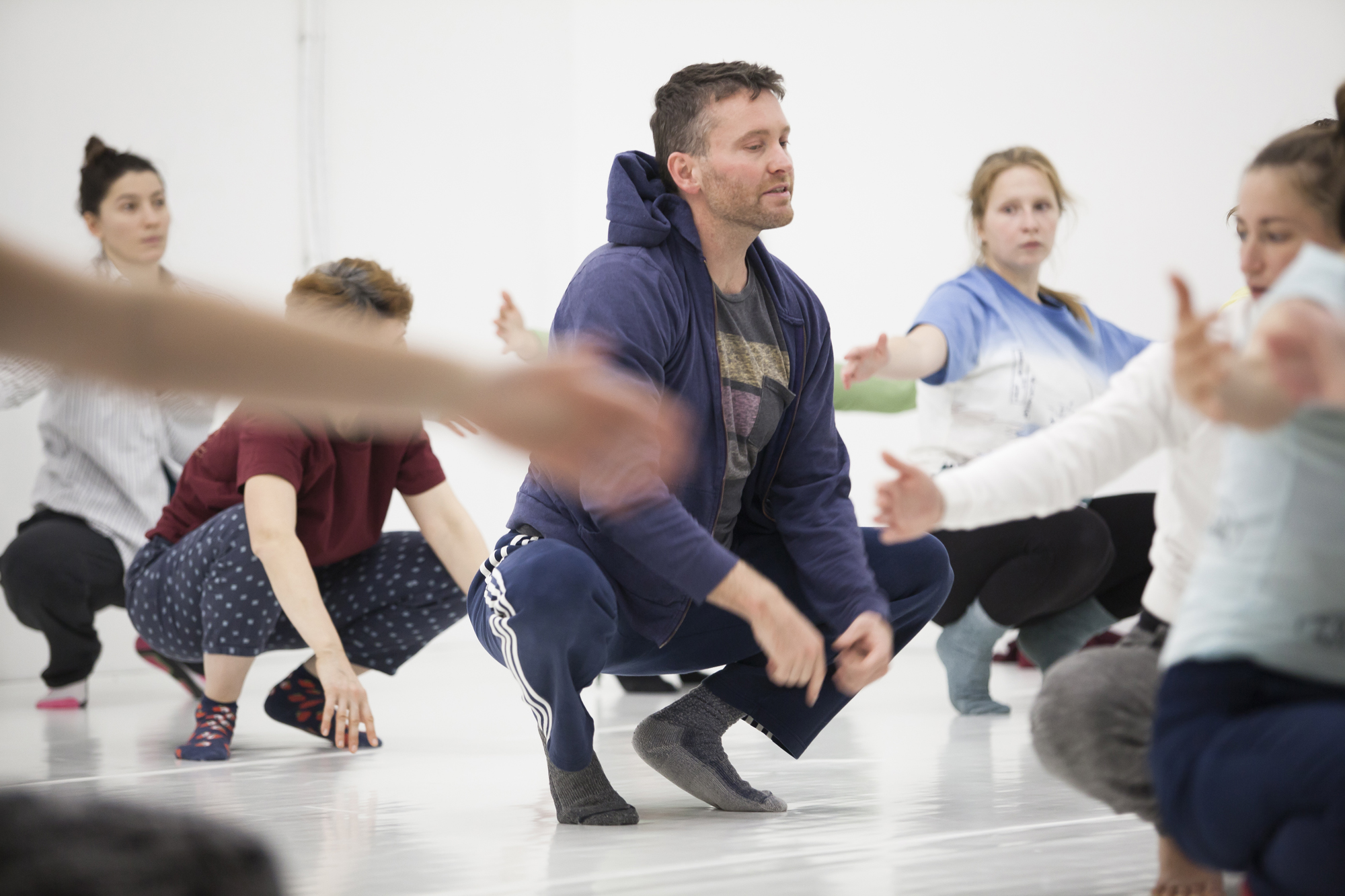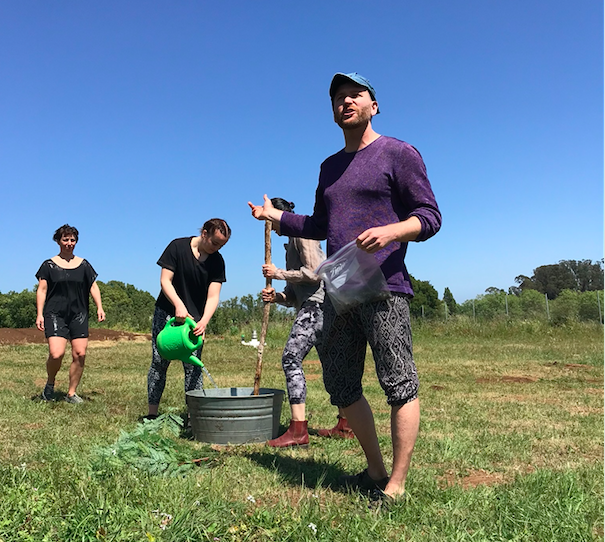Bio: Kevin O’Connor
Short:
Kevin O’Connor (he/him) I am a multidisciplinary artist whose work is rooted in
collaboration, and community-engaged arts. I work as a choreographer, dancer, teacher, improviser, circus artist, writer, and installation artist in London Ontario, and the San Francisco Bay Area. My artistic practice engages improvisation, ritual, imagination, and collective score-making as tools for imagining emergent worlds. I am involved in a decade-long artistic collective in London Ontario called Sweet Labour Art Collective. Our collaborative art-making explores practices of togethering across radically different sense-abilities and addresses the intersection of ecology, colonization and being together. Over the last 15 years I have worked with NAKA dance in Oakland, Skywatchers in the Bay Area, Oncogrrrls feminist art collective in Spain, Anandam in Toronto, and collaborated with Inuit hunter and designer Paulette Metuq on a project in Nunavut in the Canadian Arctic. Currently, I am excited to be collaborating with the following two different experimental dance works with many different inspiring artists: TRY (San Francisco/New York City) and All the Rage (Guelph). I completed an MFA in choreography and a Ph.D. in performance studies at UC Davis, where I researched the emerging 21st-century human biology named fascia, through a critical feminist science studies lens. I completed an MFA in choreography and a degree in circus arts from the National Circus School of Montreal. I also hold a degree in ecology from the Univeristy of British Columbia. My PhD research examines anatomies, body performance capacities, interventions, and imaginations in relation to science studies, including the material-bio-cultural tissue called fascia.
www.ecologicalbodying.com
Kevin O’Connor est un artiste multidisciplinaire qui travaille comme chorégraphe, interprète, improvisateur, artiste de cirque et d’installation. Né à London, Ontario, il est présentement basé à San Francisco. Kevin participe depuis une décennie à un petit collectif artistique de performance décoloniale et participative qui oeuvre au sein des bassins versants pollués en Ontario. Il a travaillé avec NAKA Dance à Oakland, Shakiri and Skywatchers à San Francisco, le collectif féministe Oncogrrrls en Espagne et a collaboré avec la designer et chasseuse inuite Paulette Metuq sur un projet au Nunavut, dans l’Arctique canadien. Depuis plus de dix ans, il suit l’enseignement de la communauté Axis Syllabus et est un praticien de thérapie craniosacrale biodynamique. Il détient une maîtrise en chorégraphie et travaille présentement vers un doctorat en études de performance à l’Université de Californie, Davis. Sa recherche examine les autonomies, les capacités de la performance du corps et les interventions et imaginations en relation avec les études scientifiques, incluant le matériel bioculturel nommé fascia.
Education:
Bachelor of Science Natural Resource Conservation, University of British Columbia
3-year degree in Circus Arts, from The National Circus School of Montreal
(major in aerial rope/dance and minor in clown)
MFA choreography, UC Davis (under the guidance of the late Della Davidson)
Ph.D.UC Davis
Biodynamic Cranial Sacral Practitioner
Professional Affiliations:
Member of Research in Dance Scholars
Longer:
I have completed a degree in Ecology from the University of British Columbia, a diplôme d’études collégiales from the National Circus School of Montreal, and an MFA in Choreography from the University of California Davis. I finished my Ph.D. in performance studies under the direction of Dr. Lynette Hunter and Dr. Joe Dumit in 2020. I have taught at Concordia University in Montreal, within the UC Davis Theater and Dance department and at international dance festivals in Toronto, San Francisco (Fresh Festival, 2017 and 2018), Berlin (Sensing In Festival 2016, Nomadic College 2017), Humbolt State University (Nomadic College 2016), Berkeley (Bay Area Axis Syllabus Exchange, 2018), Toronto (Love-In Festival 2016, Movement Research Intensive 2018 ), Vienna (Impulstanz with Nita Little), and Studio 303 in Montreal (2016 and 2018). I have danced with/ learned from Naka Dance, Sarah Shelton Mann, and Nita Little in San Francisco, Anandam in Toronto and I am in a long-term collaboration with choreographer Ruth Douthwright and Oneida artist Billy Jack in London Ontario where we started the Sweet Labour Art Collective.
My dance practice is first informed by a long-term engagement in community-based participatory art collaborations in the London Ontario and San Francisco Bay Area. This work sits at the crossroads between dance, decolonizing practices, ecology and participatory site-based performance. Having trained in different dance practices all of my life, environmental awareness drew me first to ecology and I began my formal education with a Bachelor of Science in Ecology at the University of British Columbia. In understanding ecology to be as much in the body as across bodies and worlds, I started a dance performance collective with Ruth Douthwright (choreographer/dancer) and Billy Jack (Oneida Nation visual artist) exploring land/ art participatory performance. Through participatory site-based performance, we investigate how participatory performance practices mobilizes communities to address contemporary urban and rural experience of ecological issues affecting them while at the same time examining and staying with the trouble of the colonial legacies. This work involves thinking with dance practices as a way to address our current ecologically fraught epoch.
My doctoral project is a study of how dance artists engage with the emerging material- biological entity called fascia or interconnective tissue through a Practice-As-Research (PaR) artistic “laboratory.’ Fascia or connective tissue- the viscous goop that connects, divides, and slides between muscles, organs, skin, and cells. It has also been found to be active, intelligent, communicative, and a kind of sensory organ—liquid, solid and mucus. Fascia research stretches between communities of biologists, massage therapists, clinicians, anatomists and pathologists, yoga and pilates teachers, Chinese medicine practitioners, pharmaceutical researchers, doctors, and dancers. My research uses the performance method called scoring from theater and dance to engage with the histories, practices, sense and science discourse on fascia. I have published work on this topic and a range of topics including dance and fascia, community-engaged art practices, improvisation and practice-as-research in performance.
As part of my research, I set up a fascia research lab. In the lab, we are questioning: What can fascia do? How is it becoming known? How is fascia a biological/cultural entanglement? What kind of stories can it tell? What methodological practices do artists, as non-scientific experts, develop to engage with scientific production in relation to fascia and how do they integrate that knowledge within future scientific and artistic endeavors? Can fascia enact a biology that is malleability, heterogeneous, creates friction, and produces the kind of unpredictability that feminist theories can relish? This class is an example of the type of interdisciplinary research that informs my teaching. Bringing together people across dance, performance, kinesiology, anthropology, ecology, education and medicine, I engage the language as well as the practices of movement.

